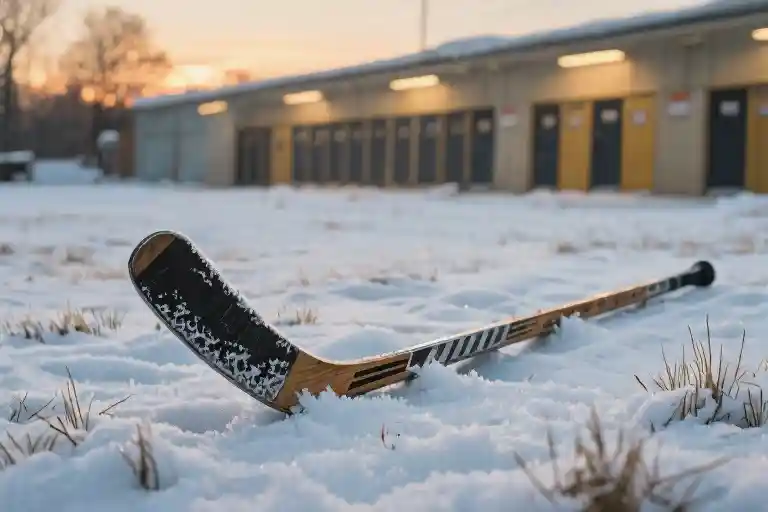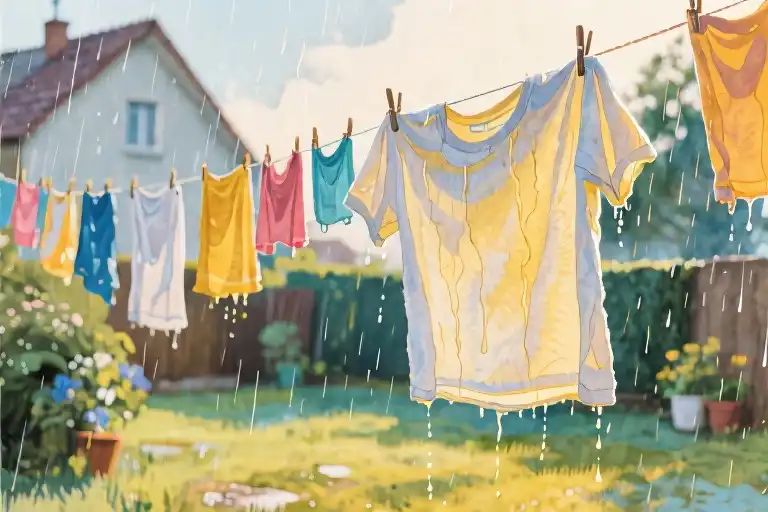The metal of the hockey stick burned with cold against my bare palms, a cruel joke of physics that made the February air feel even sharper. My knees locked in a half-bend, the unnatural stance of someone trying too hard to look like they belonged. Across the frost-whitened field, the pack moved as one organism—cleats tearing up frozen turf, breath steaming in synchronized puffs, voices tangled in a chorus of strategy shouts that might as well have been another language.
I remember thinking how warmth works differently for the included. Their cheeks glowed pink with exertion while my fingers turned waxy white inside too-big gloves. The kind of cold that seeps past skin and muscle, settling around your ribs like an unwelcome guest. Every thud of the ball against distant sticks was a reminder of my exile at defense position, the Siberia of teenage sports hierarchies.
What nobody tells you about peer pressure is how it operates in negatives. Not the dramatic “everyone’s doing it” scenarios, but the quiet erosion of standing still while the world moves around you. I hadn’t chosen hockey—it had chosen me by default, another body to fill the roster, another warm-blooded creature to validate the system. The unspoken contract: pretend enthusiasm, and maybe you’ll stop feeling like a spectator in your own life.
Somewhere between the third missed pass and a teacher’s sigh loud enough to carry across the field, a realization crystallized sharper than the ice underfoot. This wasn’t about sport at all. It was about the violence of categories, the way institutions grind individuality into neat little piles: athletic or unathletic, team player or outlier, worthy of attention or conveniently invisible.
What made the cold unbearable wasn’t the weather—it was the chilling understanding that exclusion often wears the disguise of participation. They’d given me a uniform, a position, even a stick. Everything except the permission to be terrible at something without it becoming an identity. The frost forming on the lacrosse lines that morning mirrored the creeping numbness inside: if this was belonging, I wanted no part of it.
Little did I know, walking off that field with stiff fingers and a hotter shame, how that moment would split my school years into before and after. The real price of refusing to play pretend wasn’t isolation—it was the terrifying freedom of having to find your own game.
The Frozen Hockey Field: An Outsider’s Perspective
The metal of my hockey stick burned with cold against my bare palms, though I couldn’t tell whether the trembling came from the winter air or my own nervous grip. Around me, the rhythmic thwack of sticks meeting the ball sounded like a language I’d never learned. Offside? Penalty corner? These might as well have been advanced calculus equations for all the sense they made to me.
Positioned at the far end as defense – the dumping ground for players who didn’t matter – I watched the real action unfold at a distance. My teammates moved with the synchronized frenzy of spaniels on a hunt, calling plays with shorthand terms that carried the weight of shared history. Their breath came in visible puffs of excitement while mine formed clouds of quiet resignation.
Three layers of mismatched sports gear couldn’t protect against the deeper chill of exclusion. The coach’s eyes slid past me during drills, his attention reserved for the ‘real’ players. When he did speak to our defensive line, his instructions carried the patient tone one uses with slow children or elderly relatives. ‘Just stay here and try not to let anyone through,’ he’d say, as if assigning us to be living traffic cones rather than participants in a sport.
There’s a particular loneliness that comes from being physically present but fundamentally absent. The rules never clicked for me, not because I lacked intelligence, but because no one considered it worth their time to explain them properly to someone already categorized as ‘not sporty.’ My attempts to ask questions were met with sighs and eye rolls – the universal language of inconvenience.
What stung more than the cold was realizing I’d volunteered for this exile. I’d begged my parents for the uniform, pleaded to join the team, all to avoid the greater social penalty of being the girl who didn’t play hockey at a hockey-obsessed school. Now I stood trapped in my own poor decision, counting down the minutes until I could escape the field and the uncomfortable truth: fitting in sometimes costs more than standing out.
Between plays, I’d study the other defenders. Some wore the same glassy-eyed look I felt on my own face. Others had perfected the art of appearing engaged while mentally being anywhere else. We were the island of misfit athletes, united only by our shared irrelevance to the game’s actual outcome.
The most painful moments came when the ball did rarely venture into our territory. Panic would rise as all eyes suddenly turned our way – teammates expecting competence, opponents sensing weakness. My stick became a foreign object in my hands, my feet tangled in their own private rebellion against coordination. The few times I managed to make contact with the ball, the hollow ping of plastic meeting wood sounded more like failure than achievement.
By mid-season, an unspoken agreement settled between the coaches and me. They stopped expecting anything beyond my physical presence, and I stopped pretending this was anything but a sentence to be served. The real sport became enduring the weekly humiliation without letting the hurt show. I learned to mask my discomfort behind what I hoped passed for concentration, staring intently at nothing while my mind wandered far from the frozen field.
Looking back, what surprises me most isn’t how bad I was at hockey, but how little anyone tried to make it better. The system had labeled me early, and labels – once applied – prove remarkably resistant to change. In that environment, being unskilled wasn’t a temporary condition to be improved, but a permanent identity to be managed. The cold wasn’t just in the air; it was in the way the entire structure iced over anyone who didn’t fit its narrow definition of athleticism.
The Silent Victory: When Running Shoes Shatter Labels
The first time I felt it was during a mandatory fitness test—that rare sensation of my body working with me instead of against me. While others groaned through shuttle runs, my breathing settled into a rhythm that matched the pounding of my sneakers on the track. No awkward grip on a hockey stick, no confused glances at teammates. Just the steady beat of feet against earth, each stride whispering: This. This is yours.
For three months, I trained in stolen moments. Before school, when frost still clung to the grass. After classes, when the hockey team dominated the fields. My training log (a repurposed math notebook) filled with small victories: April 3—ran 5K without stopping. April 17—beat personal best by 28 seconds. The pages smelled of sweat and pencil shavings, a tactile counterpoint to the sterile frustration of team sports.
Race day arrived with unexpected clarity. From the starting gun’s crack to the final stretch, the world narrowed to two elements: the burn in my lungs and the white line ahead. When I crossed first—a full minute before the hockey team’s star forward—the silence was louder than any cheers. Teachers who’d perfected the art of ignoring me now averted their eyes with military precision. Their clipboards might as well have been shields.
What stung wasn’t the lack of congratulations. It was the realization that my victory threatened something fundamental—their carefully sorted boxes of athletic and non-athletic, the cognitive shortcuts that let them dismiss students like me. By excelling outside their expected categories, I’d become a glitch in their system. Their silence was the sound of cognitive dissonance, of labels crumbling underfoot like autumn leaves.
The trophy gathered dust on my shelf, but its lesson stayed sharp: When institutions insist on seeing only what they expect to see, our greatest triumphs may be the ones that leave them speechless. Running taught me more than endurance—it revealed how brittle the walls of others’ expectations can be when you refuse to stay within them.
The Anatomy of Labels: Education Under the Microscope
The moment my cross-country victory was met with institutional silence, I finally understood the machinery at work. Schools don’t just accidentally categorize students into ‘sporty’ and ‘non-sporty’ piles—this classification serves a purpose. It’s the cognitive shorthand of an overburdened system, where labeling becomes the grease that keeps the conveyor belt moving.
Why Schools Manufacture Athletic Labels
Physical education departments operate on economy of attention. With limited resources and standardized curricula, the quickest way to manage thirty squirming adolescents is to identify the ‘naturals’ and focus coaching there. My hockey stick fumbling marked me as an outlier—someone whose improvement would require disproportionate effort compared to the potential return. In a system that values visible achievements (trophies, inter-school competitions), investing in the uncoordinated seems like poor resource allocation.
But the damage runs deeper than logistical convenience. These labels become self-fulfilling prophecies through what psychologists call confirmation bias. Once tagged as ‘non-athletic’, every stumble reinforces the category—while any contrary evidence (like my running stamina) gets dismissed as anomaly. Teachers aren’t being malicious; they’re victims of the same cognitive traps that make us see patterns where none exist.
The Afterlife of Labels
Ten years after leaving that frostbitten hockey field, I tracked down classmates who’d been similarly categorized. Sarah, who hid in the locker room during netball, now leads wilderness expeditions. James, perpetually picked last for football, designs ergonomic keyboards for gamers. Our ‘non-sporty’ labels said nothing about our physical capabilities—only about our refusal to conform to narrow definitions of athleticism.
What’s revealing is how these classifications linger. Multiple studies show that children labeled as poor performers in PE demonstrate decreased physical activity levels well into adulthood. The label doesn’t just describe—it prescribes. When educators confuse ‘not thriving in traditional sports’ with ‘incapable of physical excellence’, they aren’t making observations. They’re writing futures.
Rewriting the Script
The solution isn’t complicated—it’s just inconvenient. Instead of sorting students, we might sort activities. A ‘Sports Multidimensional Assessment Matrix’ I’ve seen implemented in progressive schools evaluates eight vectors:
- Kinesthetic Intelligence (body awareness)
- Strategic Thinking (gameplay comprehension)
- Endurance Threshold (sustained effort capacity)
- Social Motivation (team vs solo preference)
- Risk Appetite (contact sports tolerance)
- Spatial Sequencing (movement memorization)
- Equipment Affinity (tool-based activities)
- Environmental Response (indoor/outdoor performance)
This framework explains why I failed at hockey (low equipment affinity, weaker spatial sequencing) while excelling in cross-country (high endurance threshold, minimal social motivation). Most importantly, it prevents the reductive either/or categorization that left me—and countless others—out in the cold.
Labels are lazy. Education shouldn’t be. When we mistake our classifications for reality, we don’t just misjudge students—we miss them entirely. That silent finish line wasn’t just a personal snub; it was the sound of a system failing to recognize its own blind spots.
When Snowflakes Find Their Landing
The grass stains on my daughter’s knees tell a better story than any report card ever could. She’s sprinting across the school field not because some coach demanded it, but because the wind feels good against her cheeks today. There’s no position to play, no team to disappoint—just the simple arithmetic of breath meeting motion. Watching her, I finally understand what education owes every child: not a mold to fit into, but a compass to find their own north.
The Warmth of Unconventional Paths
Labels freeze potential. That hockey field taught me how cold it feels to be shoved into someone else’s idea of athleticism. But the running track? That was where I learned thawing begins when we stop begging for acceptance and start honoring our peculiar rhythms.
Three ways to melt the ice:
- Redefine ‘Sporty’
The soccer-obsessed gym teacher who ignored me still works at that school. But last year, he started a rock-climbing club after seeing ‘non-athletic’ kids scale the rope ladder with startling grace. Sometimes, changing the game is easier than changing minds. - Celebrate the Misfit Victories
When my daughter won her first chess tournament, we framed the scoresheet next to her swimming certificates. Diversity of achievement deserves equal wall space. - Build Your Own Tribe
The internet dismantles geography. A teenager in Nebraska who hates basketball can now train with a virtual parkour community. Rejection from one group just means your people are gathering elsewhere.
Where the Snow Lands Softly
Education’s true temperature isn’t measured by how many trophies a school displays, but by how many different kinds of children feel the warmth of being seen. My old hockey stick still gathers dust in some storage room, but the lesson sticks deeper:
We don’t find belonging by standing where we’re told to stand, but by running—however awkwardly—toward the places that make our pulse quicken with something louder than duty.





